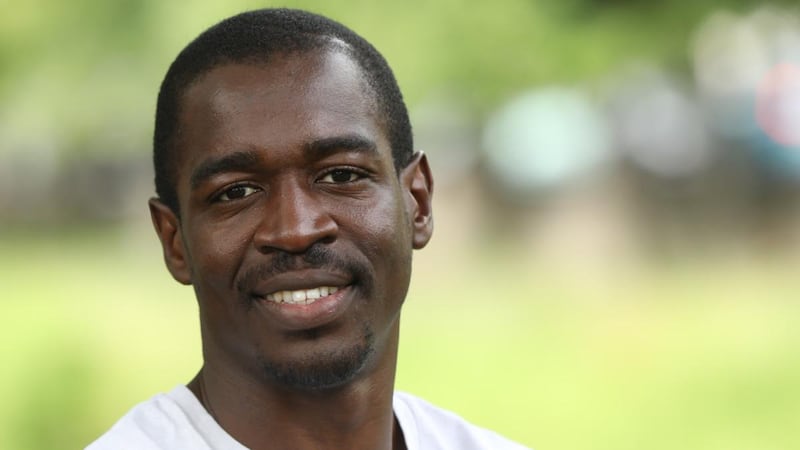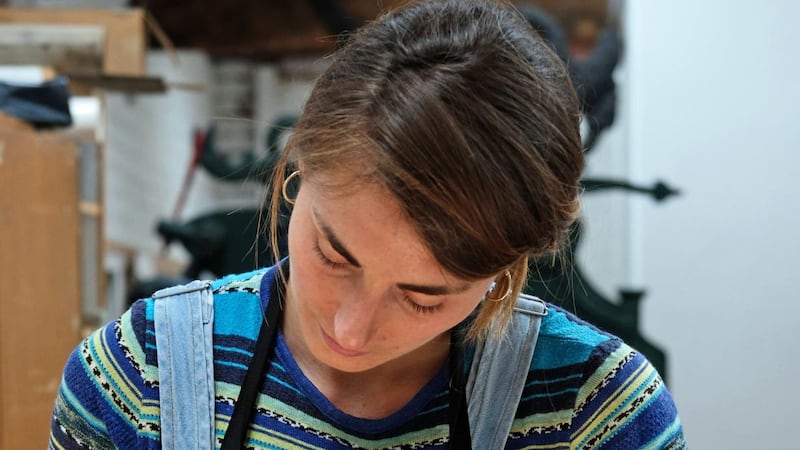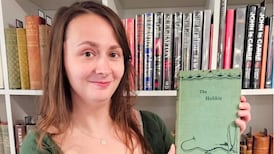The “starved artist” is a longstanding and unhelpful trope. Ask any artist and I’m sure they’ll tell you that they like eating as much as the next person. Why has society normalised the idea that financial sacrifice and art-making should go hand in hand? Where is arts funding going and to whom, how can artists make money and not be shy to ask for it, and how can institutions support emerging artists so that they don’t burn out and give up?
Aoife Scott is a printmaker and painter from Dublin. “The Arts Council awards are notoriously difficult to win,” she says. “I found the people who get them have been trying and applying for a long time – they’ve got the lingo down,” she says. “There are online workshops to provide you with the application details and how to fill out a form. But I would love to see examples of previous successful applicants who have won large sums of money. That would be really important. I’d love to hear from some of those people.”
Scott received an Agility Award through the Arts Council earlier this year, having missed out on funding on three previous occasions. For Scott, securing funding this time around was due to a few things: practice, practice, practice, along with approaching and asking for feedback from the funders. “I find approaching funding bodies quite intimidating or scary,” she says, “but they do give very good feedback. For example you can’t just give a general idea of a project, they want to know the specifics. I’ve got better over time and I force myself to write and write.”
The Agility Awards were a pilot that awarded applicants who had never received funding from the Arts Council before. “I think the Arts Council was easier on people this year,” says Scott. “I think they may have realised it was the same people winning awards. They wanted to reach out to those who maybe weren’t as confident, not because they didn’t have a good project.
Agility Awards
“There was a huge buzz around the Agility Awards, about how easy people found the whole process,” says Monica Corcoran, strategic development manager at the Arts Council. “We were delighted to hear that. We did make the material much more accessible and user-friendly. We had it translated into plain English by the National Adult Literacy Agency. We broke up the material into smaller sections and we tried to communicate it out more widely,” she says. The Agility Award was the first time artists like Scott had a chance to be recognised – but did it extend to the communities that tend to be underrepresented in the arts?
Chinedum Muotto is a self-taught poet and multi-disciplinary artist who is currently completing residencies at IMMA and Dublin City Culture Company. Originally from Biafra in Nigeria, Muotto moved to Ireland when he was 10. He studied business and then sociology before pivoting into the art world, but as a black person in Ireland he is constantly reminded that historically, funding has not been awarded to people like him.
“We live in a very competitive, nepotistic society. How funding is being dispersed is competitive,” he says. “It’s all about money and economics. We can talk about the arts all we want – if I am an emerging artist from an already-underrepresented community, basically I am poor, I don’t have money. If I don’t have money and I have not had access to these powerful institutions, how can I do anything beyond the scope of my own community? What about single mothers who want to apply for funding, they may need help with childminding – or people on social welfare? How does the likes of the Arts Council diversify so they can reach these people?’
Marginalised communities
Corcoran and her team have led out on their equality, human rights and diversity policy over the past 18 months. She discusses some of the work being done to address a lack of access to funding for marginalised communities. “Last year, we ran a consultative process with artists from a diverse range of backgrounds and there was a strong perception that the arts in Ireland was a closed shop, particularly for people who didn’t come from Ireland. That the decisions were made by middle-class, white people who appointed those who were similar to themselves. There are a lot of complex institutionalised things that are going to have to be addressed over time. We don’t want people to feel there is any sort of institutional barrier,” she says.

Time – or a lack of it – is also a huge barrier for artists. Artists are time-poor, without money they are a one-person show running their own business, from managing budgets, to producing projects and being social media savvy to networking, writing proposals and pitching their work. “That’s before you get to making any art,” says Muotto.
“These applications are so tedious, I spend 75 per cent of my time applying for these things. The whole process is so time-consuming,” he says. “We are working within a corporate structure where you need to deliver the art on time at a certain moment, art doesn’t always work that way – it’s process-driven as opposed to product- and result-driven. You need to sit with it.”
The arts officer at Fingal County Council, Rory O’Byrne, emphasises the importance of giving people space and time. He explains how his office doesn’t always seek to award artists with a fully conceptualised project, moreso they wish to give artists the opportunity to reflect on their practice in order to develop their projects. “I’m looking to give people a chance to be creative – this takes time and peace and quiet,” he says. Along with Arts Council funding, Scott successfully secured funding from Fingal Arts Office which has a remit to award money to its local artists. She spoke with artist friends and peers and learned that local arts offices provide fantastic supports for new and emerging local artists. “I approached Fingal to discuss my project plans with them, and the whole process was very easy,” she says.
Solo exhibition
Thanks to this funding, Scott was in a position for the very first time to hire people to help her produce and host her first solo exhibition. Along with financial support,Scott was also awarded a residency at Loughshinny Boat House – an art studio in north Co Dublin and the perfect place to create her work, which explores themes of the sea and nature. “I applied with the aim to prepare my work there, it was the perfect location for me – to be by the sea.” The studio gave her the time and space to make her art.
There are other arts offices in the country that understand the importance of giving a project time. Ann Marie McGing, acting arts officer at Mayo County Council runs a tight ship, in collaboration with arts and disability co-ordinator Damien O’Connor. Over almost two decades, Mayo Arts Office has fostered a countywide culture of supporting people with a disability to produce new work. This has resulted in legacy projects such as Upstart which, since its inception in 2010, has led to 51 partnership projects, engaging 116 artists and facilitators around the county. “The Upstart programme has been running for 11 years now. We award 90 per cent of our applicants. It’s a small pot of money, but it’s the difference between a project happening, and not happening,” says McGing.

‘The groups that we work with now are pretty established, they have been doing this for a number of years. We’d be a very approachable resource – we run clinics around the application process to explain what we’re looking for and what kind of supporting materials make it a better application. I would encourage everyone who applies for funding, regardless of ability, to make sure you go back. Funding bodies are more than happy to give you that support. We want people to make better applications.”
‘Artists as clowns’
“Our success has been two decades in the making. These things don’t happen overnight,” she says. While Mayo and Fingal are representative of a number of engaged local arts offices around the country, there are still vast gaps to fill. “We’re still trying to reach places that don’t have ease of access to arts provision,” says Corcoran. “It’s critical this happens in childhood – that’s where people develop their cultural capital and their comfort with the arts and culture.”
“What is culture to Irish people?” asks O’Byrne. “It’s probably more to do with traditional music and sport. Change has to happen in education. Look how it’s reported in the media. You hear some quirky story about some odd piece of art, people then see artists as clowns. Art colleges need to provide courses on ‘How to present yourself to the art world’, to arm artists with skills to survive. The great success of Irish artists is being able to survive,” he says.
Just surviving for artists shouldn’t be the status quo. “I have huge respect for artists in their 50s and 60s who survived, some gave up on having families or on secure housing,” says O’Byrne.
This level of commitment to their artform may be commendable, but it’s not acceptable. Institutions must help artists so they can do more, with more, so that they can not only survive, but thrive.











